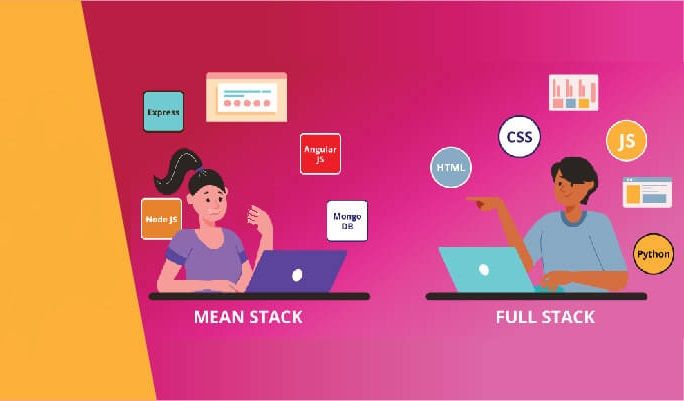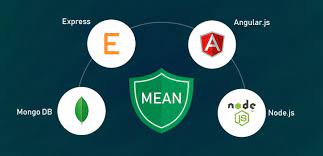Hire MEAN Stack Developer in 2023 detailed guide
What is a MEAN stack developer?
If you're taking your first steps in web development or seeking to broaden your established skills, a career as a MEAN stack developer could be an excellent pathway to consider. This distinct area of expertise blends intricate website construction know-how with the user-friendly interface and platform offered by Oracle's JavaScript. Diving into the realm of this profession can assist you in pinpointing whether it resonates with your professional aspirations.
The MEAN stack, a JavaScript-centric framework, provides a comprehensive toolkit for web application development. This aptly named stack is an acronym representing MongoDB, Express, Angular, and Node - the four integral technologies forming the backbone of the stack.
- MongoDB: Positioned as a NoSQL database, MongoDB places a premium on document-centric operations. It grants MEAN stack developers an array of features like effortless scalability, superior performance, automatic failover, and high availability, fortifying their web applications' security.
- Express JS: Express JS stands as a robust web application framework synergizing with Node.js to build web server applications. It amplifies the base capabilities of Node.js, equipping MEAN stack developers with resources to render their web applications more versatile and feature-rich.
- Angular JS: Angular JS, a technology compatible with numerous computer languages, is a boon for developers during their applications' design phase. It enables them to sculpt views using HTML and implements controllers to bridge the gap between the view and the web model.
- Node.js: Primarily, Node.js serves as the framework for crafting scalable network applications within the JavaScript platform. Being server-side technology, it permits the development of digital applications tailored for online use.
The MEAN stack isn't a standalone entity and has variants such as MERN (where Angular.js is replaced with React.js) and MEVN (featuring Vue.js). The MEAN stack holds an esteemed position amongst the technology paradigms for constructing web applications.
A MEAN stack developer is a specialized IT professional who constructs websites leveraging four unique JavaScript technologies. Java represents an online foundation where developers, programmers, and other tech enthusiasts can fashion websites. These MEAN stack developers form a specific segment of full-stack IT professionals, who manage both the front-end and back-end aspects of development. Thus, as they share the same foundational knowledge, MEAN stack developers primarily engage the MEAN toolkit. This user-oriented toolkit streamlines the creation of dynamic websites and applications.
You may also like: Everything You Should Know About NET Developers
What responsibilities does a MEAN stack developer shoulder?
- Crafting and delivering high-architectural web solutions
- Implementing push notifications and additional interactive web elements
- Creating interactive consumer data across diverse systems and seamlessly abstracting it to the user interface via a Node.js backend
- Tackling and rectifying technical glitches
- Teaming up with researchers, data specialists, and engineers to design finely-tuned websites and systems
- Collaborating with product managers and development squads to conceive innovative software remedies
- Structuring the front-end and back-end architecture
- Authoring efficient MEAN-centric APIs
- Developing web applications and features with a keen focus on mobile-responsive design
- Testing web software and applications to ensure optimal performance
- Operating within HTML and CSS computer ecosystems
- Exploring novel concepts and offering insights into the MEAN open-source stack
- Supervising application and software rollout
- Ensuring code quality through thorough validation
- Automating critical unit tests
- Managing backlog duties, prioritizing tasks, and overseeing the successful completion of development projects.
MEAN Stack Applications
Although the MEAN stack may not be the ideal fit for all scenarios, it undoubtedly shines in several areas. With its scalability and concurrent user management, it serves as an excellent choice for crafting cloud-native applications. Furthermore, its AngularJS frontend framework optimally supports the development of single-page applications (SPAs), offering all information and functionalities on one consolidated page. Some practical examples of MEAN stack applications include:
- Organizational Calendars
- Expense Monitoring Systems
- News Aggregator Websites
- Mapping and Location Discovery Platforms
You might be interested in: Flutterflow: A Revolutionary Cross-Platform Development Framework
Benefits of Utilizing the MEAN Stack
MEAN applications adopt a versatile, write-once, cross-platform approach. As MEAN is remarkably adept for real-time applications those in particular that are native to the cloud, and dynamic single-page web applications crafted in Angular.js, it's equally suited for a range of other scenarios, such as:
- Workflow Management Systems
- News Aggregator Websites
- Task and Calendar Applications
- Interactive Discussion Platforms
Of course, the applications for the MEAN stack extend far beyond these examples. As all stack components are grounded in JavaScript and JSON, the integration among these elements is seamless and intuitive.
Moreover, Express and Angular - the E and A of MEAN - rank among the most sought-after JavaScript frameworks for back-end and front-end development, respectively. Express simplifies routing, manages HTTP requests and responses effortlessly, and provides excellent middleware support to handle JSON endpoints and form posts. Angular serves as a potent tool for fashioning dynamic HTML pages that interact with a back-end server.
So, whether you're designing a high-throughput API, a straightforward web application, or a microservice, MEAN stands as the go-to stack for Node.js applications. As all the components of the MEAN stack are open source, they offer a generous, cost-free avenue for developers to explore and innovate.

Challenges with the MEAN Stack
However JavaScript is a powerful contemporary language, it wasn't initially conceived for back-end server construction. Given that the MEAN stack fundamentally hinges on JavaScript, including the back-end server, scalability might usher in concurrency and performance issues due to JavaScript's intrinsic characteristics.
Moreover, the swift pace of development can lead to poor isolation of business and server logic. This lack of isolation could result in a potential morass of spaghetti code and the propagation of suboptimal practices.
Lastly, despite the plethora of guides and tutorials available, they often fall short of providing specific JavaScript coding guidelines relevant to this stack. Consequently, a strategy that was highly effective for one application might cause unexpected issues when applied to another.
You may also like: Your Guide to Hiring Ruby on Rails Developers
What is the average salary for a mean stack developer?
The national average yearly remuneration for a full-stack developer stands around $90,148. This approximation may differ based on numerous factors like the professional's years of experience, geographic locale, certifications, educational credentials, and the employer's pay scale. As you hone your skills and gain deeper field experience, your proficiency may potentially command a higher income bracket.
What is a mean stack developer's work environment?
Software and application development typically involves a cooperative effort. Therefore, professionals in this arena often juggle roles, working both autonomously and in the synergy of a development team. While a large number of MEAN stack developers find their professional homes within computer system design enterprises, they are equally sought after in manufacturing firms and software publishing houses. The majority of these developers follow a full-time schedule during standard office hours, but there might be instances requiring weekend or holiday work to hit crucial deadlines. Primarily operating in an office or computer lab setting, they also enjoy the flexibility to execute their responsibilities remotely.
What are the most important skills for a mean stack developer?
- Design Aptitude: For web developers, the flair for design and creativity is pivotal. It empowers them to curate engaging and user-friendly websites. This expertise addresses not just the visual elements of a web application but also the user-friendly features and functionalities.
- Problem-Solving Acumen: Development processes can occasionally hit a snag or a vital web feature may not function as expected. In such scenarios, a MEAN stack developer needs to diagnose the problem and rectify it promptly.
- Time Management Mastery: Given the deadlines they must adhere to, MEAN stack developers need to be adept at managing their time efficiently to meet all their milestones and deliver on schedule.
- Team Collaboration: As part of a development or project team, the ability to work effectively with colleagues is vital. A willingness to receive constructive criticism and remain open to suggestions fosters a cooperative work environment.
- Communication Proficiency: Effective communication makes it easier to share progress updates, offer constructive feedback, receive criticism, and produce understandable reports. You may also need to liaise with other departments and senior team members, hence the ability to clearly express your thoughts is crucial to avoid misunderstandings.
- Technical Expertise: The role demands extensive knowledge about complex technical technologies, computers, tools, resources, and applications. To thrive as a MEAN stack developer, a commitment to continual learning is a must.
- Attention to Detail: Being detail-oriented aids MEAN stack developers in critically evaluating their work to ensure the best possible outcomes.
Conclusion
In conclusion, a career as a MEAN stack developer offers a fascinating exploration into the intricacies of web development, integrating cutting-edge technologies such as MongoDB, Express, Angular, and Node.js. The role requires a fusion of technical proficiency, creativity, problem-solving acumen, and effective communication. From designing interactive websites to ensuring the smooth operation of complex web applications, the tasks are as challenging as they are rewarding.
Although the MEAN stack has its own set of challenges and pitfalls, the benefits it offers, coupled with its versatility across various applications, render it a formidable player in the technology paradigms for web applications. As a MEAN stack developer, you are not just a builder of websites or apps, but a creator of experiences, shaping how users interact with the digital world.
Contact us at Hiretop to find MEAN stack developers, and keep in mind that the landscape of web development is dynamic, evolving, and constantly advancing. Continuous learning and staying updated with the latest trends and best practices will be your best allies. Your role goes beyond writing code, extending to collaboration, strategic thinking, and ensuring the seamless functionality of digital spaces. It's a path that's as challenging as it's rewarding, making every milestone achieved a testament to your skill, perseverance, and passion. Welcome to the world of MEAN stack development, where every line of code counts, and the possibilities are boundless. By following these steps, you can find and hire a talented MEAN stack developer who will be a valuable addition to your team.

